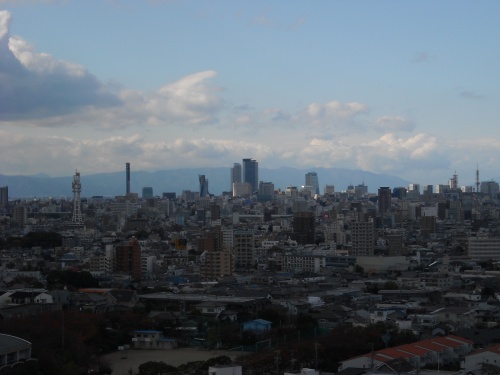部分 [bubun] means ‘portion’ or ‘piece’ in Japanese. It’s one of those words that never showed up on a vocabulary test, but the professors (all seven of them) simultaneously started using it about two weeks ago, much to the confusion of about two-thirds of my class.
What’s the shopping like?
I can divide my shopping experience into four categories – specialty shops, convenience stores, malls, and grocery stores.
The malls are…new? I don’t recall seeing any two years ago, or three years ago, or four years ago. They do seem to be a bit older than that, though not by much. They are very much so like your average American mall with way too many clothing stores, houseware stores, CD stores, and typically an excellent bookstore. There’s also usually a food court (complete with Subway and McDonalds) and some sort of gaming arcade.
Department stores play a smaller part in shopping here than they do in American malls, rather, all of the malls I’ve been to in Japan have had a grocery store attached instead. There usually is one department store available, though they only occupy one floor and sell mainly brand name clothing and accessories. Besides the food court, there are various sit-down restaurants concentrated in a separate area, only accessible from inside the mall.
While these seem to be gaining in popularity (I saw a rather frighteningly large number of them on the train from Nagoya to Okazaki, a nearby, smaller city), Japanese people still seem to prefer specialty shops. There’ no real equivalent to Walmart or Target in Nagoya that I’ve seen, no get-it-all-at-once stores. A shop that specializes, the wisdom seems to go, is focused and highly skilled at what they do, probably because their livelihood depends on it.
Thinking about Tucson (my hometown) and St Paul (my college town), I would definitely say that free-standing, specialty stores are more common for day-to-day shopping, followed closely by department stores. Obviously, proximity matters – a nearby department store offers most of the same things as scattered specialty shops will win out, even in the Japanese mind. I’ve been to small CD stores, stores that just sell black ink, too many small bookstores to count, fruit stands, stationery stores, tombstone shops, and tea shops, just to name a few. Specialty shops don’t have to be small here, though. Electronic stores and bookstores especially, can swell to enormous proportions, though I haven’t seen any of the chain takeover business that you get with Borders and Barnes & Noble in the US. Sure, we have major chains like Maruzen and Kinokuniya, but for every branch they have, there’s a small bookstore operating in a branch subway station.
Convenience stores are king here. I can name seven within ten minutes walk of my current location, and there’s probably more over the hill that I don’t know about because I’ve only lived here for two and a half weeks. I’ve been in Japan long enough, however, that I can’t quite remember the differences between Japanese and American convenience stores, but I’ll probably be vastly disappointed when I get home.
A few items of note – convenience stores here sell such items as spare underwear, extra socks, books, adult magazines, bananas (and rarely any other fruit), a fairly large selection of stationery and, starting in the cooler months, oden – stewed goodies that you can select to go, such as hard-boiled eggs, fish cake, and tofu. Yummy.
Finally, grocery stores. They’re fairly small, unless you happen upon one attached to a mall. There’s always an attached bakery, with excellent quality bread, usually for very cheap. Wandering up and down the aisles, you can get a pretty good idea of what’s universal and what’s not. Spaghetti is, as is spaghetti sauce (though it comes in a pouch, rather than a jar), canned soup is not. Sliced bread always comes in packets about 15-20 centimeters wide, the only difference between loaves is the number of slices you get for your money, 4, 5, 6, or 8. In other words, you pay 108 yen no matter what (for store brand bread), and get the same amount of bread, just different thicknesses.
There’s no deli counter that I’ve seen, just meat out for display. There’s usually a sushi counter though and nearby you can find prepared meals of rice, croquettes (various bits of breaded and deep-fried who-knows), and pickles.
Various Japan-specific treats I’ll miss – yoghurt flavored drinks everywhere, iced salty rice cakes, a type of citrus that’s somewhere between a clementine and an orange, enormous sweet grapes, oden, potato croquettes.
How does Nagoya compare to the other places you’ve been to in Japan?
Okay, for starters, where I’ve been in Japan besides Nagoya – Tokyo, Kyoto, Nara (the ancient capital), Hakone (but only for a day), the fifth station on Mt Fuji (for about 3 hours), and the Izu peninsula.
We’ll eliminate Mt Fuji and Hakone right away, since I don’t have a very strong impression of either of them. Mt Fuji’s a lot more impressive 100 miles away, rather than sticking off of the side of it.
The Izu peninsula is exceedingly rural and where I’ve spent the most time. Houses, schools, and businesses vied for space with rice fields, the ocean, and the mountains. Very different from Nagoya.
Between Nagoya and Tokyo, I would say that this is one of the few cases in which Tokyo comes out with a better image of history and culture. Nagoya was pretty much burnt to the ground in World War II and lost many of the cultural resources it previously had (even Nagoya Castle got a little toasted). Furthermore, when the time came to rebuild, they made the decision to have very wide, “convenient” boulevards for cars. This resulted, vexingly, in one of the highest rate’s for traffic deaths for a prefecture in Japan. Whoops.
Another difference – walk anywhere in Tokyo city limits and within 5-10 minutes I guarantee that you will practically fall into a subway station. I had managed to trick myself into thinking Nagoya’s subway system was fairly extensive, though less so than Tokyo’s.
Nagoya has 4 major subway lines. Tokyo has 13. The map looks like a spider web.
Nagoya does not compare in any way to Kyoto or Nara with their hundreds and hundreds of years of history. On the whole, I believe it suffers culturally, but is a well-enough place to live, though it definitely has it’s nicer areas in which to live.
What was the reaction to the US election?
From the Japanese people? No idea. Japanese news reporting can be a little…obtuse. The English-language newspaper that I can follow here at the dorm, The Japan Times, follows a rather happy-go-lucky style of news distribution. From what I can tell, they are less exuberant than Europe, but not angry or disappointed in any visual way. Mostly, I think that Japanese college students can visualize what impact it will have on their lives and so have no strong opinions either way.
From the other foreigners studying at CJS? Very pleased. You’d think that we were sheepherders whose best ewe had just dropped triplets; cigars and backslaps all around.
That’s the last of these question posts, unless something else suddenly occurs to you guys. Next week, I’ll do a post about the dorm, then there’s 12 on the 12th. Things are starting to wrap up here, with final exams and final papers and planning out how to get to the airport. That last one seems to be on order of marshalling an army.















